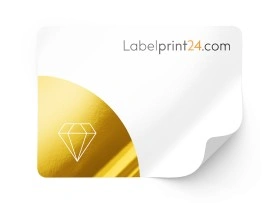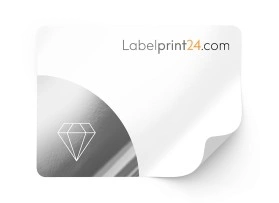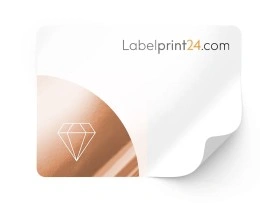- Products
- Service & Help
 Our printing experts will be happy to help you with any questions you may have about your order. Simply use our customer support.SupportNewsletter
Our printing experts will be happy to help you with any questions you may have about your order. Simply use our customer support.SupportNewsletter - About us
 Our printing experts will be happy to help you with any questions you may have about your order. Simply use our customer support.SupportNewsletter
Our printing experts will be happy to help you with any questions you may have about your order. Simply use our customer support.SupportNewsletter - Contact us
- Key Clients
Labels with a finish
Are you looking for a label that makes your product look attractive and appealing? A refined label that offers special protection against external influences? Order labels with finishing from Labelprint24.com!
- For a promotional and decorative appearance
- Protection against abrasion, dirt and moisture
- Finishing for a High Label value
Discover more labels of Labelprint24.com!
- Production TimeFrom 48hr
- MaterialFilm / Paper
- Size100% customizable
- Finish OptionsFilm finishing / Varnish / Laminate
Select kind of product

Product Advisor for Labels
Whether it’s a simple roll label or a multi-layered specialty label – I’m your go-to person for questions concerning materials, adhesion, and finishing of labels for the pharmaceutical, cosmetic, food, chemical, and almost any other industry.
"Paper or film? We've got the perfect label!"
I will be happy to help you personally.
Labels with finishes for high-quality product labelling
1. What are refined labels?
Labels with finishes or finished labels are self-adhesive labels whose surface properties have been specifically changed or improved by various finishing processes. The finishing is carried out immediately after the print motif has been applied. The finishes can be functional, purely decorative or a combination of both.
The structure of labels with finishes hardly differs from the general structure of self-adhesive labels. The difference is made by the additional finishes on the top label layer. Depending on the customer's wishes, this can be one or more finishes. Like all self-adhesive labels, embellished labels consist of several layers of material; this is called a laminate. These layers include the upper material made of paper or label film, the adhesive underneath, the release layer made of silicone and the backing material.
The detailed properties of labels with finishes depend on whether the stickers will later be used outdoors or indoors and, of course, on their intended use. First and foremost, it is the finishes that turn a simple adhesive label into an attractive cosmetic or resistant chemical label. With our finishing techniques, it is possible to present your product and its printed packaging in an impressive way and to distinguish it even better from competing products.
The finishes that Labelprint24 offers as a professional label manufacturer include varnishing with UV protective varnish, laminating, hot foil stamping, digital hot foil printing and the application of tactile warning triangles. All finishing is done with the latest technology and in the very best quality.
2. Typical applications of labels with finishes
Labels with finishes are used for two main reasons:
The first reason is to optimise the surface to better protect the labels from external influences. These influences include UV radiation, moisture such as rain and water vapour, chemicals such as acids or alkalis, mechanical abrasion, extreme temperatures, salt water, grease and oils. All these factors can render an unfinished label illegible or, in the worst case, destroying it completely. A typical finishing example to better protect labels is lamination.
The second reason why labels are often finished is to improve their look and feel as well as their promotional decorative appearance. A typical example to achieve these effects is hot foil stamping.
2.1 Examples of typical industry applications of labels with finishes
Examples of finished labels include:
- Product labels
- Wine labels
- Cosmetic labels
- Chemical labels
- Bottle labels
- Beer labels
- Security labels
- Freezer labels
- Food labels
- No-label look labels
- Wet glue labels
- Packaging sleeves
- Tin labels
- Spice labels
Chemical labels made of paper and film are required for the labelling of products in the chemical industry. The requirements for labelling in this industry are very strictly regulated. It is particularly important for the product labelling of chemicals that all information, such as ingredients, weight, warnings and much more, is permanently legible and, depending on the product and processing, resistant to acids, alkalis, UV or solvents. They must be abrasion-resistant, resistant to chemicals and solvents and have a long service life. To ensure these properties, chemical labels made of label paper are usually finished. It is not a matter of beauty, but of protection and durability. That is why many chemical labels made of paper are coated with a UV-protective varnish. UV-curing varnishes are cured in seconds and are then scratch-resistant and insensitive to chemicals, oils, greases and moisture. Fading of the colours and thus deterioration of legibility is impossible.
Labels with decorative finishes are needed, for example, for cosmetics and high-quality food and beverages. These articles stand in several rows on the supermarket shelves, close together with the products of the competitors. With the help of an unusual packaging design that stands out from the crowd, one can achieve that the consumer reaches for the article that he either knows or that spontaneously catches his eye. Hot foil stamping or partial varnishing, for example, are ideally suited for this sales-promoting purpose, as they make the respective product appear noble and of high quality.
3. The production of labels with finishes
3.1 Materials
Labels with finishes are also made from label paper laminate or film laminate before finishing. Polypropylene, PVC and polyethylene are used as label film. The decisive factor for the choice of material is the subsequent area of application of the labels. Especially outdoors, film labels are preferable to paper labels, as contact with liquids and UV radiation is the order of the day here. Optionally, there is the possibility to finish a paper label with a protective laminate.
3.2 Printing process
Labelprint24 uses modern digital printing systems to produce printed labels with finishes. Digital printing is characterised by brilliant colours, excellent print quality and cost advantages compared to conventional printing processes. In addition, digital printing enables the inexpensive production of short runs and uncomplicated personalisation of the labels with changing motifs and coding. At Labelprint24 you can have all labels printed with finishes in rectangular and round standard formats on the roll. We also produce round labels or rectangular stickers in individual sizes.
3.3 What refinements are there?
There are many ways to refine a label and enhance its emotional impact. The costs for this also vary greatly. They are directly related to the customer's request, the degree of finishing and the printing and finishing technology used. The finishes available at Labelprint24 include matt and glossy UV protective coatings, laminations, hot foil stamping, digital hot foil printing and the application of a tactile warning triangle.
3.3.1 The UV protective coatings
Matt and glossy UV protective coatings have become an indispensable part of label production. They are usually used to protect the surface against soiling, scratches, abrasion, scuff marks or moisture. But UV coatings not only protect the label from environmental influences, but they are also used for different design variants. The coating is applied inline, i.e. integrated into the printing process, and then immediately irradiated with UV light. This process causes the photo initiators in the UV coating to react and the synthetic resin particles to cross-link immediately. The UV coating is cured within seconds and the label roll comes out of the press dry. UV coatings protect the paper label from yellowing. Depending on the varnish used, the surface of the labels may have a brilliant or duller shine.
3.3.2 The lamination
When it comes to 100% surface protection or a particularly high-quality gloss effect, film lamination is an optimal solution. During lamination, a wafer-thin plastic film, for example made of polyester, is applied to one or both sides of the paper label. Various films are available for this purpose: Matt films, glossy films or soft-touch films. The laminating film not only protects against loss of quality, but also enhances the surface optically and haptically. Labels with a laminated surface look more noble and of higher quality than other printed matter. High-gloss film, for example, achieves a much higher gloss effect than gloss varnish.
3.3.3 Hot foil stamping
Hot foil stamping is suitable for a particularly glossy and high-quality appearance of your labels with finishes. Hot foil stamping is the transfer of stamping foils to the material to be finished by means of pressure and heat, without deforming the substrate in the process. This requires an embossing die and a special hot stamping foil. Hot stamping foils are available in different designs as gold, silver or coloured foils, but also effect foils or hologram foils are available. These embossing foils consist of several layers, a transfer layer and an adhesive layer.
3.3.4 The digital hot foil printing
With modern industrial digital printing systems, it is not only possible to print digitally, but also to finish. One example of this is digital hot foil stamping. Digital hot foil stamping no longer requires an embossing tool but transfers the transfer layer of a special silver or gold embossing foil onto digitally pre-printed toner layers. At temperatures above 80 °C, the thermoplastic components of the multilayer foil melt. Under simultaneous application of pressure, the colouring metallic layers dissolve and combine with the toner particles. There is no change in the shape of the substrate. The firmly fixed film can then be further printed using digital printing.
3.3.5 The tactile warning triangle - digital embossing
If several layers of UV varnish are printed on top of each other in one and the same spot, tactile warning triangles can be created for the blind and visually impaired. The UV varnish is applied to the label and becomes tactile. The transparent dots of varnish are printed up to 50 times on top of each other to achieve this effect. Instead of embossing, this process can be used for labelling and as an anti-counterfeiting element of pharmaceutical packaging: it is also called digital embossing.
The advantages of labels with finishes
Enhanced labels from Labelprint24 are ideal for further improving the functional and decorative properties of adhesive labels. Our labels appeal to several senses at the same time, arouse emotions and thus make a lasting impression on your customers. We have briefly summarised the most important advantages of our labels with finishes for you:
- Decorative, glossy surfaces
- Longevity and good durability
- Suitable for outdoor applications
- The labels stand out from the crowd
- For pleasant haptic effects
- More attention for your product
- They improve the value of the product
- Protection against abrasion, dirt and moisture










